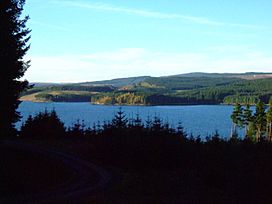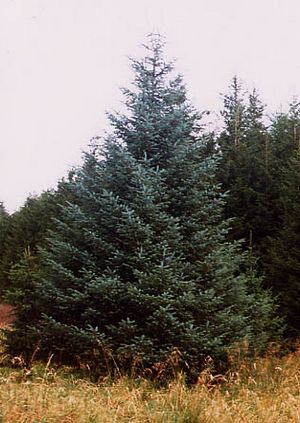Kielder Forest facts for kids
Quick facts for kids Kielder Forest |
|
|---|---|

Kielder Forest and reservoir, looking north-west from Yarrow
|
|
| Map | |
| Geography | |
| Location | Northumberland, England |
| OS grid | NY665905 |
| Coordinates | 55°12′29″N 2°31′41″W / 55.208°N 2.528°W |
| Area | 250 square miles (650 km2) |
| Administration | |
| Governing body | NY665905 |
Kielder Forest is a huge forest in Northumberland, England. It surrounds Kielder village and the Kielder Water reservoir. This forest is the largest man-made woodland in England. About three-quarters of its 250 square miles (650 km2) are covered by trees. Most of Kielder Forest is part of the Border Forest Park. The southern part, called Wark Forest, is inside Northumberland National Park.
Contents
History of Kielder Forest
How the Forest Started
The United Kingdom's Forestry Commission owns and manages Kielder Forest. They started planting trees here in the 1920s. In the 1930s, the Ministry of Labour helped by sending unemployed people to work in the forest. Many of these workers came from mining towns and shipyards in North East England.
They lived in special camps set up by the Ministry, often on Forestry Commission land. One of these camps in Kielder is now covered by Kielder Water. New villages, like Stonehaugh, were also built for the workers' families.
From Open Land to Forest
Before the 1920s, the area was mostly open moorland. People used it for grouse hunting and sheep grazing. There were only small patches of natural woodland along streams and in rocky areas. The Forestry Commission bought this land to create a large supply of timber for the country. This was their main goal until the 1960s.
Since then, how the forest is managed has changed. Now, it also focuses on protecting the environment and offering fun activities for visitors. At the same time, it still provides a steady supply of timber. Kielder Forest is still owned by the state. Its journey from a single-purpose plantation to a multi-purpose forest shows how forestry has grown in the United Kingdom.
Ancient History in the Forest
You can find many archaeological remains within the forest. These old sites are an important link to the often wild and turbulent history of the area.

Geography of Kielder Forest
The name "Kielder Forest" often refers to the surrounding hills and remote moorland too. These hills connect with the Cheviots to the north-east. The highest point is Peel Fell, which is 602 metres (1,975 feet) tall. The area also includes the Marilyns (hills over 600m) called Sighty Crag and Larriston Fells.
Even though these hills are not super high, they feel very remote. This is because there are very few towns or roads nearby. In fact, Sighty Crag is the furthest hill in England from any road, about four miles away!
Environment and Wildlife
Trees in Kielder Forest
Kielder Forest is mostly filled with conifer trees. These are trees that have needles and cones, like Christmas trees. Sitka spruce (Picea sitchensis) covers 75% of the planted area. This type of tree grows very well in the damp weather of northern Britain.
Other trees include Norway spruce (Picea abies) and lodgepole pine (Pinus contorta), which each cover 9% of the forest. The rest of the forest has trees like Scots pine (Pinus sylvestris), larch (Larix spp.), Douglas-fir (Pseudotsuga menziesii), and broadleaf trees. Broadleaf trees have flat leaves that usually change color and fall off in autumn. Examples include birch (Betula spp.), rowan (Sorbus aucuparia), cherry (Prunus spp.), oak (Quercus spp.), beech (Fagus sylvatica), and willow (Salix spp.).
Timber Harvesting
Every year, about 475,000 cubic metres of timber are harvested from Kielder. This timber is used by local businesses that make sawn wood, chipboard, pulp (for paper), and wood fuel. Most of this wood comes from areas where trees are clearfelled, meaning all trees in a section are cut down. However, more and more wood is now taken from areas using "continuous cover silviculture" where only some trees are removed at a time.
When an area is clear-felled, new coniferous and broadleaf trees are replanted. This also creates chances to make more open spaces and improve the areas along rivers and streams. All timber from Forestry Commission woodlands, including Kielder, is certified by the Forest Stewardship Council. This means it comes from forests that are managed responsibly.
Wildlife in Kielder Forest
Kielder Forest has several special areas called Sites of Special Scientific Interest. These are important for the moorland environment. There is also an ongoing project to restore Border mires, which are types of wetlands.
The forest is home to about half of England's red squirrel population. It is their biggest safe place in the country. You might be able to see one at the squirrel hide near Kielder Waterside. The forest is also a great home for many birds of prey. In 2009, a pair of osprey (Pandion haliaetus) successfully built a nest and raised young in the forest. They have nested there every year since. By 2016, there were four nesting osprey pairs, and they raised eleven young! A large number of roe deer also live here and are carefully managed.
Because there are not many people, roads, or railways, Kielder Forest was suggested in 2016 as a good place to bring back the Eurasian lynx. This wild cat has not lived in Britain for 1,300 years. People became even more interested in bringing them back after a successful breeding program for the Iberian lynx in Spain.
Fun Activities and Attractions
Kielder Castle Visitor Centre
Kielder Castle Visitor Centre was once an 18th-century hunting lodge. It was built by the Duke of Northumberland. Now, it is a visitor and information centre. It is located near Kielder Village, at the start of the River North Tyne valley. The Castle is a central point for many fun activities. You can find walking and cycling trails, picnic areas, and a forest drive here. It is said that a big football match took place between men from Tynedale and Redesdale at Kielder Castle in 1790.
Other Attractions in the Forest
The forest has several interesting art and building projects. One is a Skyspace designed by James Turrell. Another is Wave Chamber, which is a camera obscura built inside a stone pile by Chris Drury.
You can also visit the Kielder Observatory in the forest. This is a special place for looking at the stars and planets.
In 2010, former British runner Steve Cram started the Kielder Marathon. This race goes all the way around the lake and through the gentle hills of the forest.
Around the same time, the local government started turning off street lights late at night. This helps make the sky darker in the park. They also supported observation facilities and advertised to attract visitors. Kielder has some of the darkest skies in mainland Britain, which is great for stargazing!
Rallying in Kielder Forest
Kielder Forest has been used a lot for rallying (a type of car racing). The forest tracks are known by drivers and fans as being very challenging. They have long straight sections where cars can go very fast. But they also have tricky corners, deep ditches close to the road, and rough surfaces.
Historically, the WRC RAC Rally often included stages in Kielder. Commentators even called it "Killer Kielder." This was because many rally cars would often crash or break down in Kielder during the event. National rallies, historic rallies, and British Rally Championship events still use the forest today.
Images for kids










